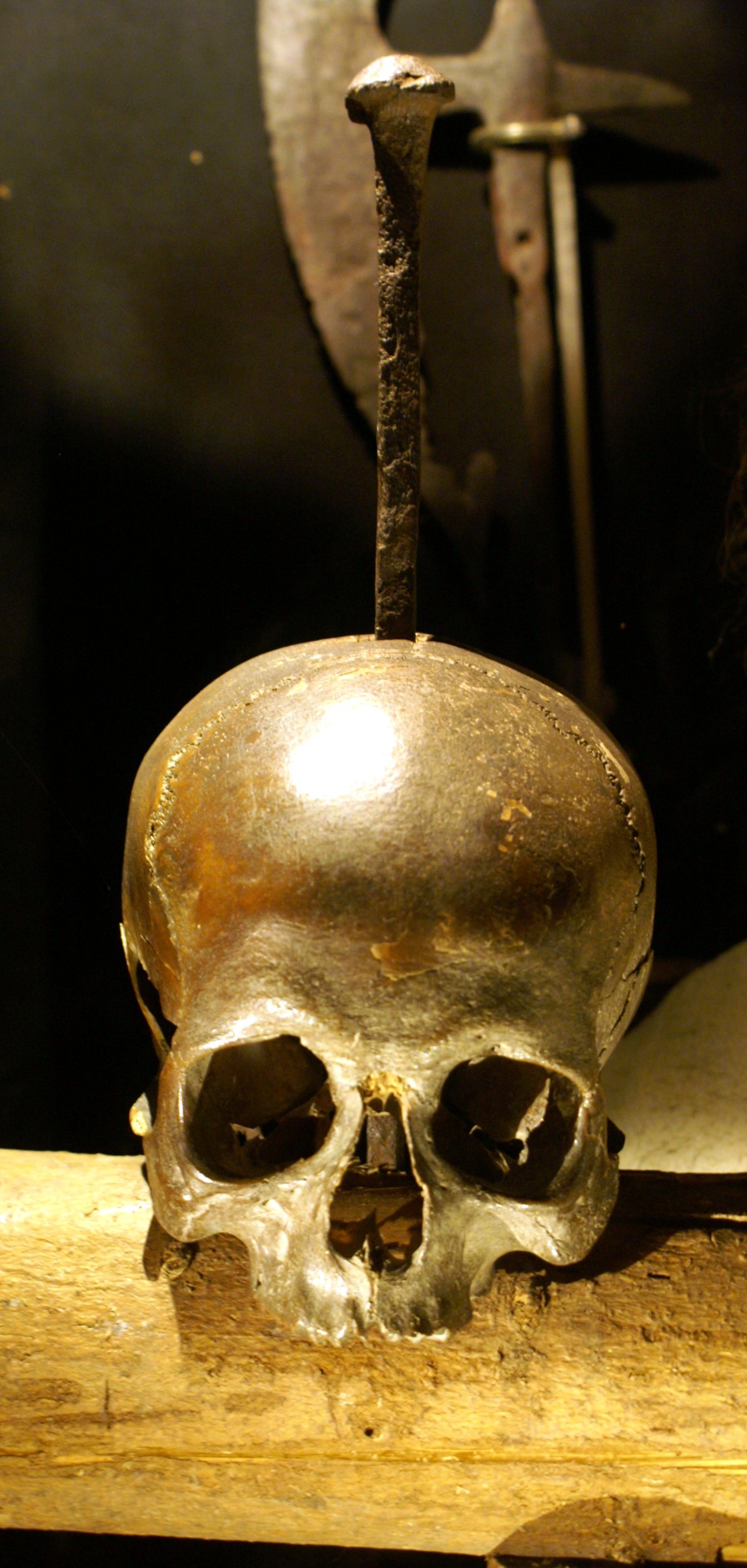Medieval History

A nail-pierced skull believed to belong to the legendary medieval pirate Klaus Störtebeker has been stolen from a museum in the northern German port city of Hamburg, authorities said Tuesday.
The skull was stolen from the Museum for Hamburg History on January 9, but the museum didn't immediately announce the theft so as not to hamper the investigation. It wasn't clear how the exhibit was stolen, or why.
"We are all very upset about the theft," museum director Lisa Kosok said in the press release. "We very much hope that it will either be returned or found."
The museum said it was offering a reward of several thousand euros for information leading to the recovery of the skull, but didn't give an exact amount
The skull, impaled on a large rusty nail, was discovered in 1878 during construction for a warehouse district in an area where pirates had earlier been beheaded and their heads displayed on spikes as a warning against other pirates.

The museum displayed the skull since 1922, which is missing its jawbone. The museum also did a reconstruction of the face based on information from the skull.
Later forensic analysis determined that the skull may well belong to a man beheaded around 1400, although not necessarily Stoertebeker.
The museum tried to use DNA analysis of the skull to compare it with possible descendants, but they failed to find a definite match.
Klaus Störtebeker (c. 1360 ? 20 October 1401), was a leader and the best known representative of a companionship of privateers known as the Victual Brothers. The Victual Brothers were originally hired during a war between Denmark and Sweden to fight the Danish and supply the besieged Swedish capital Stockholm with provisions. After the end of the war, the Victual Brothers continued to capture merchant vessels.
A large number of myths and legends surround the few facts known about Klaus Störtebeker's life. Störtebeker is only a nickname, meaning "empty the mug with one gulp" in Old German. The moniker refers to the pirate's supposed ability to empty a four-litre mug of beer in one gulp.
His ship was captured in 1401 and Störtebeker and his crew were taken to Hamburg, where they were executed outside the walls of the Hanseatic League city. When authorities took apart his ship they discovered that the masts contained cores of gold, silver and copper.
See also our earlier news article: Medieval pirates plundered the Baltic Sea, study finds
- Oops! Brain-removal Tool Left In Mummy's Skull
A brain-removal tool used by ancient Egyptian embalmers has been discovered lodged in the skull of a female mummy that dates back around 2,400 years. Removal of the brain was an Egyptian mummification procedure that became popular around 3,500 years...
- Face Of Slain 14th Century English Archbishop To Be Revealed Soon
Almost 630 years of waiting are almost over as the face of Suffolk?s most iconic and tragic figure is set to be revealed. Forensic experts from Dundee University have been working to put a face to Simon Theobald of Sudbury who had his head hacked off...
- Stolen 14th-century Italian Painting Found In The United States
A 14th-century triptych painting, which was stolen from an Italian villa nearly 40 years ago, has been found in a museum in Kentucky. US government officials announced yesterday that the art piece, a three-panel wooden triptych, which depicts the Virgin...
- The Battle Of Towton: Nasty, Brutish And Not That Short
The soldier now known as Towton 25 had survived battle before. A healed skull fracture points to previous engagements. He was old enough?somewhere between 36 and 45 when he died?to have gained plenty of experience of fighting. But on March 29th 1461,...
- Brain Surgery Was Performed In Ninth-century Ireland
Remarkable new details were revealed this week from the discovery of a medieval grave in County Donegal in Ireland. One of the most notable is that archaeologists have come across the remains of a young woman buried around the year 800 AD who underwent...
Medieval History
Skull of Medieval Pirate stolen from German Museum

The skull was stolen from the Museum for Hamburg History on January 9, but the museum didn't immediately announce the theft so as not to hamper the investigation. It wasn't clear how the exhibit was stolen, or why.
"We are all very upset about the theft," museum director Lisa Kosok said in the press release. "We very much hope that it will either be returned or found."
The museum said it was offering a reward of several thousand euros for information leading to the recovery of the skull, but didn't give an exact amount
The skull, impaled on a large rusty nail, was discovered in 1878 during construction for a warehouse district in an area where pirates had earlier been beheaded and their heads displayed on spikes as a warning against other pirates.

Later forensic analysis determined that the skull may well belong to a man beheaded around 1400, although not necessarily Stoertebeker.
The museum tried to use DNA analysis of the skull to compare it with possible descendants, but they failed to find a definite match.
Klaus Störtebeker (c. 1360 ? 20 October 1401), was a leader and the best known representative of a companionship of privateers known as the Victual Brothers. The Victual Brothers were originally hired during a war between Denmark and Sweden to fight the Danish and supply the besieged Swedish capital Stockholm with provisions. After the end of the war, the Victual Brothers continued to capture merchant vessels.
A large number of myths and legends surround the few facts known about Klaus Störtebeker's life. Störtebeker is only a nickname, meaning "empty the mug with one gulp" in Old German. The moniker refers to the pirate's supposed ability to empty a four-litre mug of beer in one gulp.
His ship was captured in 1401 and Störtebeker and his crew were taken to Hamburg, where they were executed outside the walls of the Hanseatic League city. When authorities took apart his ship they discovered that the masts contained cores of gold, silver and copper.
See also our earlier news article: Medieval pirates plundered the Baltic Sea, study finds
- Oops! Brain-removal Tool Left In Mummy's Skull
A brain-removal tool used by ancient Egyptian embalmers has been discovered lodged in the skull of a female mummy that dates back around 2,400 years. Removal of the brain was an Egyptian mummification procedure that became popular around 3,500 years...
- Face Of Slain 14th Century English Archbishop To Be Revealed Soon
Almost 630 years of waiting are almost over as the face of Suffolk?s most iconic and tragic figure is set to be revealed. Forensic experts from Dundee University have been working to put a face to Simon Theobald of Sudbury who had his head hacked off...
- Stolen 14th-century Italian Painting Found In The United States
A 14th-century triptych painting, which was stolen from an Italian villa nearly 40 years ago, has been found in a museum in Kentucky. US government officials announced yesterday that the art piece, a three-panel wooden triptych, which depicts the Virgin...
- The Battle Of Towton: Nasty, Brutish And Not That Short
The soldier now known as Towton 25 had survived battle before. A healed skull fracture points to previous engagements. He was old enough?somewhere between 36 and 45 when he died?to have gained plenty of experience of fighting. But on March 29th 1461,...
- Brain Surgery Was Performed In Ninth-century Ireland
Remarkable new details were revealed this week from the discovery of a medieval grave in County Donegal in Ireland. One of the most notable is that archaeologists have come across the remains of a young woman buried around the year 800 AD who underwent...
